

Compact Muon Solenoid
LHC, CERN
| CMS-PAS-EXO-16-052 | ||
| Search for dark matter, invisible Higgs boson decays, and large extra dimensions in the ℓℓ+EmissT final state using 2016 data | ||
| CMS Collaboration | ||
| May 2017 | ||
| Abstract: A search for new physics in events with a Z boson produced in association with large missing transverse momentum with the CMS experiment at the LHC is presented. The search is based on the 2016 data sample of proton-proton collisions at √s= 13 TeV corresponding to an integrated luminosity of 35.9 fb−1. The results of this search are interpreted in terms of a simplified model of dark matter production with spin-0 or spin-1 mediators, a standard model Higgs boson decaying invisibly and produced in association with the Z boson, as well as a model with large extra spatial dimensions. For all models, no significant deviation from the background expectation is found, and limits are set with respect to relevant model parameters. | ||
|
Links:
CDS record (PDF) ;
inSPIRE record ;
CADI line (restricted) ;
These preliminary results are superseded in this paper, EPJC 78 (2018) 291. The superseded preliminary plots can be found here. |
||
| Figures & Tables | Summary | Additional Figures | References | CMS Publications |
|---|
| Figures | |
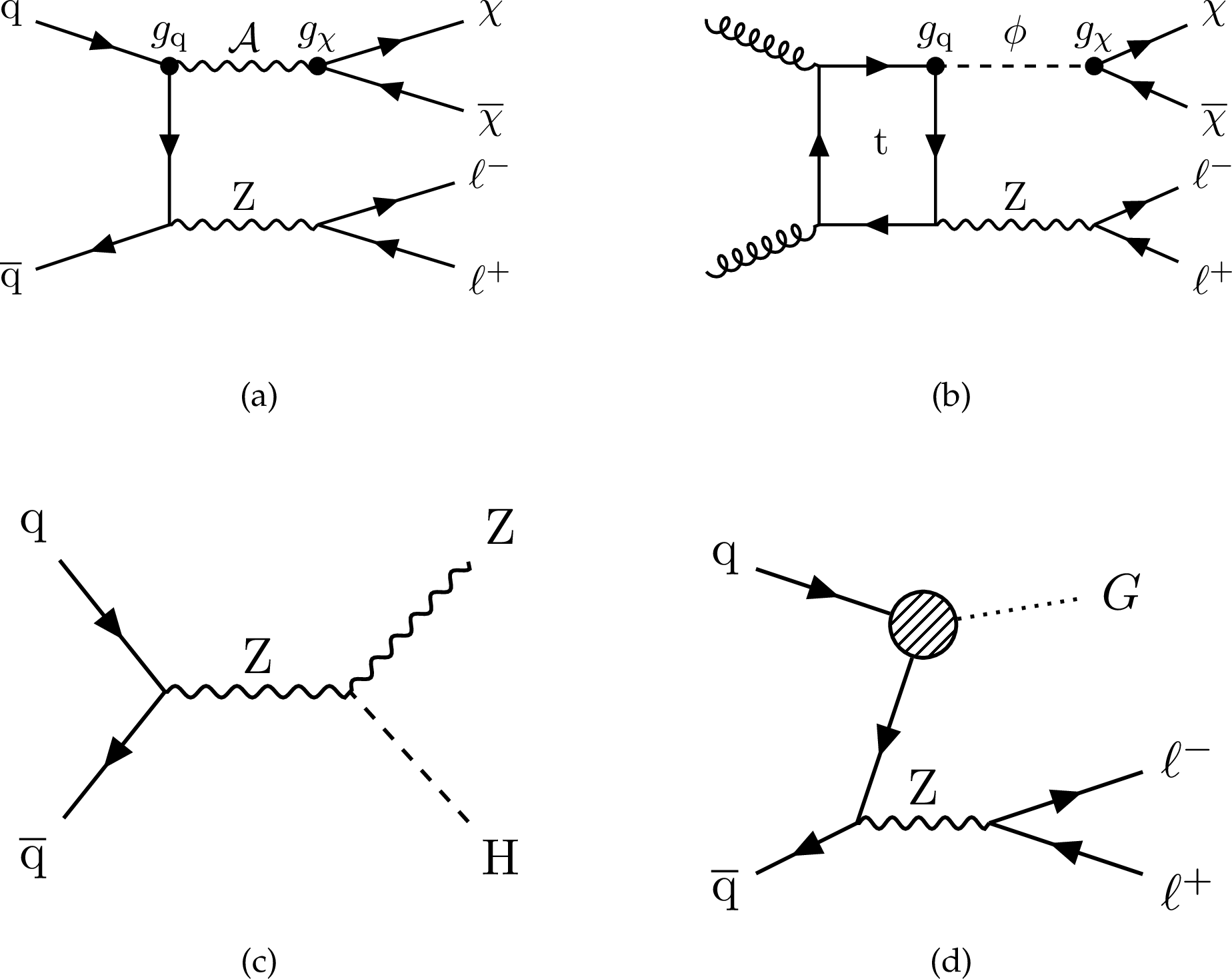
png pdf |
Figure 1:
Feynman diagrams illustrative of the beyond the standard model processes considered in this paper: (a) dark matter production in a simplified model with a spin-1 mediator A; (b) dark matter production in a simplified model with a spin-0 mediator ϕ; (c) production of a Higgs boson in association with Z boson with subsequent decay of the Higgs boson into invisible particles; (d) graviton production in the scenario of large extra dimensions. |

png pdf |
Figure 1-a:
Feynman diagram illustrative of one of the beyond the standard model processes considered in this paper: dark matter production in a simplified model with a spin-1 mediator A. |

png pdf |
Figure 1-b:
Feynman diagram illustrative of one of the beyond the standard model processes considered in this paper: dark matter production in a simplified model with a spin-0 mediator ϕ. |
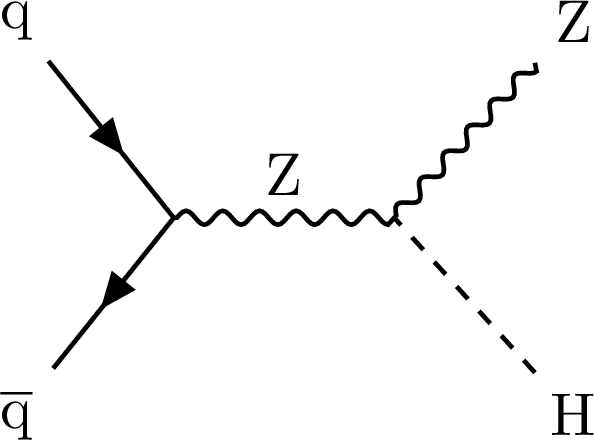
png pdf |
Figure 1-c:
Feynman diagram illustrative of one of the beyond the standard model processes considered in this paper: production of a Higgs boson in association with Z boson with subsequent decay of the Higgs boson into invisible particles. |
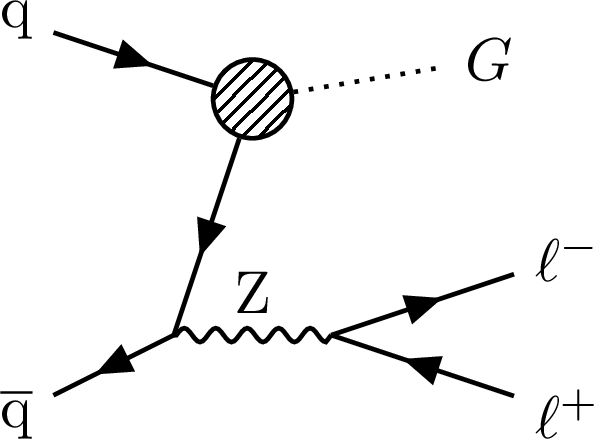
png pdf |
Figure 1-d:
Feynman diagram illustrative of one of the beyond the standard model processes considered in this paper: graviton production in the scenario of large extra dimensions. |

png pdf |
Figure 2:
Emulated ETmiss distribution for the WZ→3ℓν (top left) and ZZ→4ℓ (top right) control regions, and the ratio between both distributions in data and simulation (bottom). Uncertainty bands correspond to the combined statistical and systematic components. |
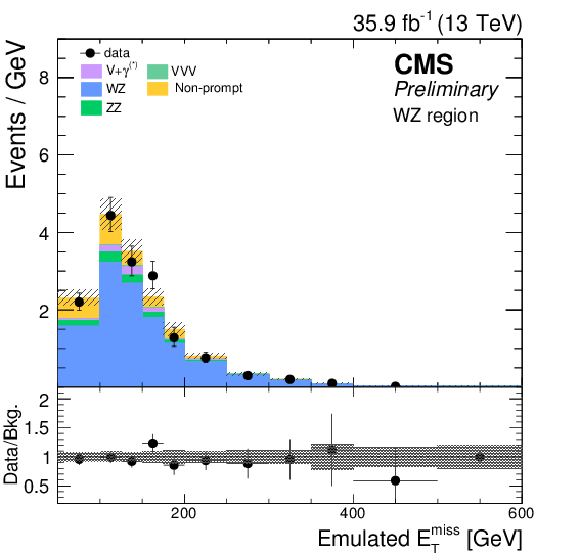
png pdf |
Figure 2-a:
Emulated ETmiss distribution for the WZ→3ℓν control region. Uncertainty bands correspond to the combined statistical and systematic components. |
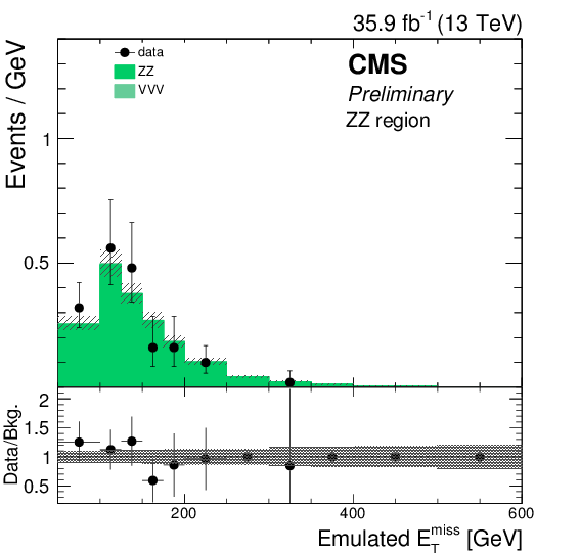
png pdf |
Figure 2-b:
Emulated ETmiss distribution for the ZZ→4ℓ control region. Uncertainty bands correspond to the combined statistical and systematic components. |

png pdf |
Figure 2-c:
Ratio between distributions in Fig.2-a and Fig.2-b, in data and simulation. Uncertainty bands correspond to the combined statistical and systematic components. |

png pdf |
Figure 3:
Post-fit distribution of the BDT classifier in the diboson control regions: (left) WZ three-lepton region; (right) ZZ four-lepton region. |

png pdf |
Figure 3-a:
Post-fit distribution of the BDT classifier in the WZ three-lepton control region. |
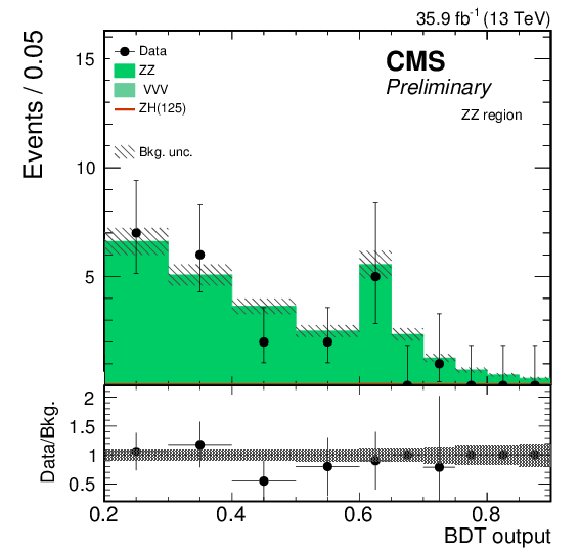
png pdf |
Figure 3-b:
Post-fit distribution of the BDT classifier in the ZZ four-lepton control region. |
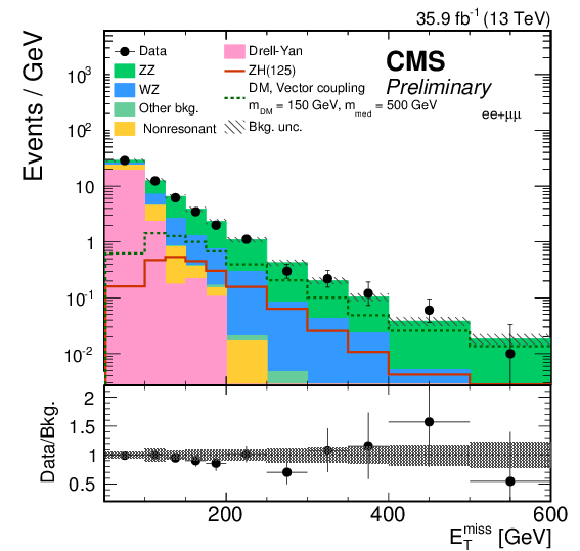
png pdf |
Figure 4:
Distribution of the ETmiss in the ee+μμ channel after the full selection, including the region between 50 and 100 GeV. The last bin also includes any events with ETmiss> 600 GeV. The uncertainty band includes both statistical and systematic components. The ZH(inv.) signal normalization assumes SM production rates and B(H→inv.)=1. |

png pdf |
Figure 5:
The 95%CL expected and observed limits on σobs/σtheo for the vector (left) and axial-vector (right) mediated DM scenario with gq= 0.25. Limits are not shown for far off-shell (2mDM>1.5mmed) regions of the parameter space. |

png pdf |
Figure 5-a:
The 95%CL expected and observed limits on σobs/σtheo for the vector mediated DM scenario with gq= 0.25. Limits are not shown for far off-shell (2mDM>1.5mmed) regions of the parameter space. |

png pdf |
Figure 5-b:
The 95%CL expected and observed limits on σobs/σtheo for the axial-vector mediated DM scenario with gq= 0.25. Limits are not shown for far off-shell (2mDM>1.5mmed) regions of the parameter space. |
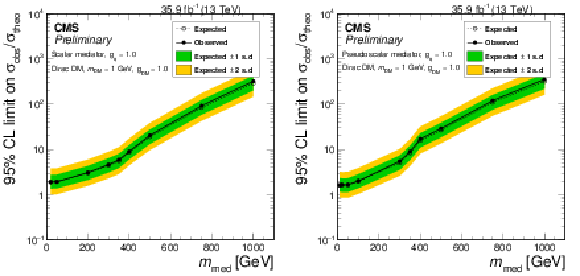
png pdf |
Figure 6:
The 95%CL expected and observed limits on σobs/σtheo for the scalar (left) and pseudoscalar (right) mediated DM scenario with gq= 1. The limits are parameterized as a function of mediator mass mmed for fixed dark matter mass mDM= 1 GeV. |

png pdf |
Figure 6-a:
The 95%CL expected and observed limits on σobs/σtheo for the scalar mediated DM scenario with gq= 1. The limits are parameterized as a function of mediator mass mmed for fixed dark matter mass mDM= 1 GeV. |

png pdf |
Figure 6-b:
The 95%CL expected and observed limits on σobs/σtheo for the pseudoscalar mediated DM scenario with gq= 1. The limits are parameterized as a function of mediator mass mmed for fixed dark matter mass mDM= 1 GeV. |

png pdf |
Figure 7:
Observed 90% CL limits on the DM-nucleon scattering cross sections in both spin-independent (left) and spin-dependent (right) cases, assuming a mediator-quark coupling constant gq= 0.25 and mediator-DM coupling constant gDM= 1. Limits from the LUX [75], CDMSLite [76], PandaX-II [77], and CRESST-II [78] experiments are shown for the spin-independent case. Limits from the Super-Kamiokande [79], PICO-60 [80], and IceCube [81,82] experiments are shown for the spin-dependent case. |

png pdf |
Figure 7-a:
Observed 90% CL limits on the DM-nucleon scattering cross sections in the spin-independent case, assuming a mediator-quark coupling constant gq= 0.25 and mediator-DM coupling constant gDM= 1. Limits from the LUX [75], CDMSLite [76], PandaX-II [77], and CRESST-II [78] experiments are shown. |
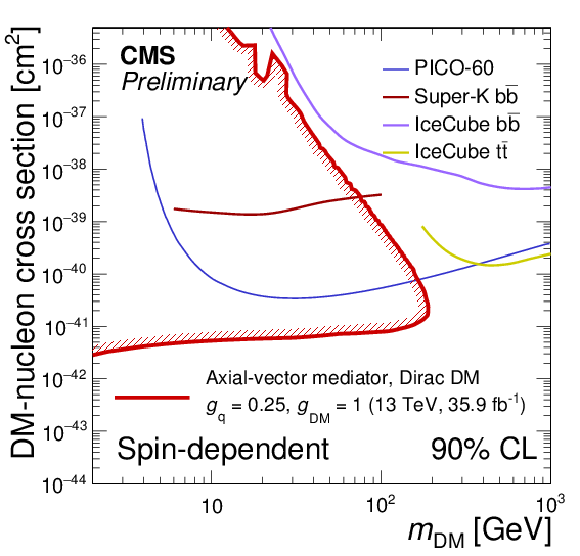
png pdf |
Figure 7-b:
Observed 90% CL limits on the DM-nucleon scattering cross sections in the spin-dependent case, assuming a mediator-quark coupling constant gq= 0.25 and mediator-DM coupling constant gDM= 1. Limits from the Super-Kamiokande [79], PICO-60 [80], and IceCube [81,82] experiments are shown. |

png pdf |
Figure 8:
Expected and observed 95% CL cross section exclusion limits for the example case n= 4 in the ADD scenario (left) and exclusion limits on MD for different values of n (right). In both plots, the markers for expected exclusion are obscured by the close overlap with the observed curves. The red solid line shows the theoretical cross section for given values of n. Cross sections are calculated for the fiducial phase space of pT(Graviton)> 50 GeV. Gray lines show the projection of the intersection between theory and expected as well as observed exclusion onto the MD axis. |

png pdf |
Figure 8-a:
Expected and observed 95% CL cross section exclusion limits for the example case n= 4 in the ADD scenario. The markers for expected exclusion are obscured by the close overlap with the observed curves. The red solid line shows the theoretical cross section for given values of n. Cross sections are calculated for the fiducial phase space of pT(Graviton)> 50 GeV. Gray lines show the projection of the intersection between theory and expected as well as observed exclusion onto the MD axis. |

png pdf |
Figure 8-b:
Exclusion limits on MD for different values of n. The markers for expected exclusion are obscured by the close overlap with the observed curves. The red solid line shows the theoretical cross section for given values of n. |

png pdf |
Figure 9:
Post-fit distribution of the BDT classifier in the multivariate analysis signal region for the SM H(inv.) decay hypothesis. |
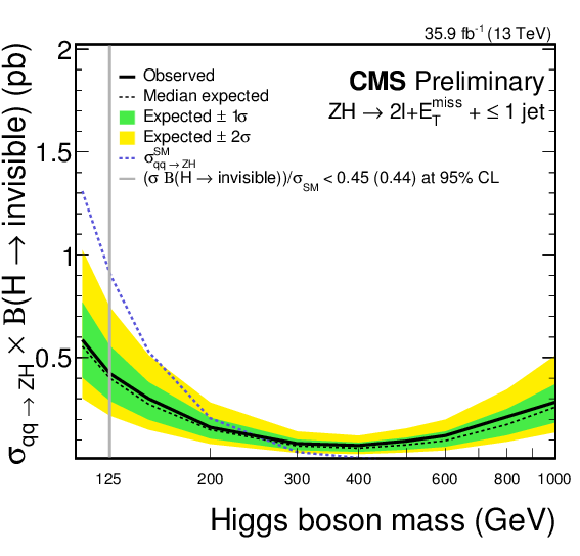
png pdf |
Figure 10:
Expected and observed 95% CL upper limits on the production cross section times branching fraction, σZH×B(H→inv.) as a function of the Higgs boson mass. |
| Tables | |

png pdf |
Table 1:
Summary of the kinematic selection requirements for the ETmiss-based analysis. |
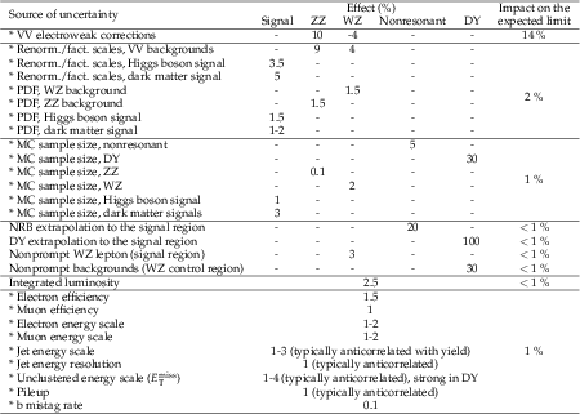
png pdf |
Table 2:
Summary of systematic uncertainties. Each uncertainty represents the variation of the relative yields of the processes in the signal region. A particular uncertainty is fully correlated across processes to which it contributes, including those processes that are also present in control regions. The symbol "-" indicates that the systematic uncertainty does not contribute or is deemed negligible. For minor backgrounds, systematic uncertainties are omitted due to the smallness of their contribution. For shape uncertainties (indicated with a *), the numbers correspond to the overall effect of the shape variation on the yield or acceptance. The impact on the expected upper limit on the signal strength, i.e.\ the relative decrease in the median expected upper limit on signal strength upon removing the nuisance, is also evaluated with respect to the SM Higgs boson signal. |
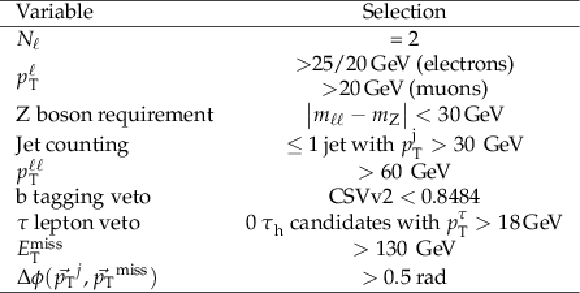
png pdf |
Table 3:
Summary of the training preselection for the multivariate analysis. |

png pdf |
Table 4:
Observed number of events, post-fit background estimates, and signal predictions. The combined statistical and systematic uncertainties are reported. |
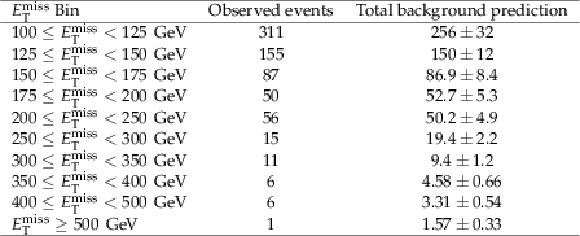
png pdf |
Table 5:
Expected event yields in each ETmiss bin for the sum of background processes in the signal region. The background yields and their corresponding uncertainties are obtained after performing a combined fit to data in all control regions, but excluding data in the signal region. The observed events in each bin are also included. |
| Summary |
| A search for new physics in events with a Z boson produced in association with large missing transverse momentum with the CMS experiment at the LHC has been presented. This search is interpreted in simplified models with both spin-0 and spin-1 dark matter mediators, a large extra-dimensional model, and in a model with a standard model Higgs-like scalar particle, each produced in association with the Z boson and decaying invisibly. The search is based on a 2016 data sample of proton-proton collisions at √s= 13 TeV corresponding to an integrated luminosity of 35.9 fb−1 and sets stringent limits on the parameter space of these models. |
| Additional Figures | |

png pdf |
Additional Figure 1:
Expected and observed 95% CL upper limits on B(H→inv.), assuming SM Higgs production cross sections, as a function of the Higgs boson mass. |

png pdf |
Additional Figure 2:
Correlations between the estimated background yields in the signal region EmissT bins. The correlations are obtained after performing a combined fit to data in all control regions, but excluding data in the signal region. |
| References | ||||
| 1 | G. Hinshaw et al. | Nine-year Wilkinson Microwave Anisotropy Probe (WMAP) Observations: Cosmological Parameter Results | Astrophys. J. Suppl. 208 (2013) 19 | 1212.5226 |
| 2 | P. Cushman et al. | Snowmass CF1 Summary: WIMP Dark Matter Direct Detection | 1310.8327 | |
| 3 | J. Buckley et al. | Indirect Dark Matter Detection CF2 Working Group Summary | 1310.7040 | |
| 4 | CMS Collaboration | Search for dark matter, extra dimensions, and unparticles in monojet events in proton-proton collisions at √s= 8 TeV | EPJC 75 (2015) 235 | CMS-EXO-12-048 1408.3583 |
| 5 | ATLAS Collaboration | Search for new phenomena in final states with an energetic jet and large missing transverse momentum in pp collisions at √s= 8 TeV with the ATLAS detector | EPJC 75 (2015) 299 | 1502.01518 |
| 6 | CMS Collaboration | Search for new phenomena in monophoton final states in proton-proton collisions at √s= 8 TeV | PLB 755 (2016) 102 | CMS-EXO-12-047 1410.8812 |
| 7 | ATLAS Collaboration | Search for new phenomena in events with a photon and missing transverse momentum in pp collisions at √s= 8 TeV with the ATLAS detector | PRD 91 (2015) 012008 | 1411.1559 |
| 8 | CMS Collaboration | Search for physics beyond the standard model in final states with a lepton and missing transverse energy in proton-proton collisions at √s= 8 TeV | PRD 91 (2015) 092005 | CMS-EXO-12-060 1408.2745 |
| 9 | ATLAS Collaboration | Search for dark matter in events with heavy quarks and missing transverse momentum in pp collisions with the ATLAS detector | EPJC 75 (2015) 92 | 1410.4031 |
| 10 | ATLAS Collaboration | Search for dark matter in events with a hadronically decaying W or Z boson and missing transverse momentum in pp collisions at √s= 8 TeV with the ATLAS detector | PRL 112 (2014) 041802 | 1309.4017 |
| 11 | ATLAS Collaboration | Search for new particles in events with one lepton and missing transverse momentum in pp collisions at √s= 8 TeV with the ATLAS detector | JHEP 09 (2014) 037 | 1407.7494 |
| 12 | ATLAS Collaboration | Search for invisible particles produced in association with single-top-quarks in proton-proton collisions at √s= 8 TeV with the ATLAS detector | EPJC 75 (2015) 79 | 1410.5404 |
| 13 | ATLAS Collaboration | Search for Dark Matter in Events with Missing Transverse Momentum and a Higgs Boson Decaying to Two Photons in pp Collisions at √s= 8 TeV with the ATLAS Detector | PRL 115 (2015) 131801 | 1506.01081 |
| 14 | CMS Collaboration | Search for Monotop Signatures in Proton-Proton Collisions at √s= 8 TeV | PRL 114 (2015) 101801 | CMS-B2G-12-022 1410.1149 |
| 15 | CMS Collaboration | Search for the production of dark matter in association with top-quark pairs in the single-lepton final state in proton-proton collisions at √s= 8 TeV | JHEP 06 (2015) 121 | CMS-B2G-14-004 1504.03198 |
| 16 | ATLAS Collaboration | Search for dark matter in events with a Z boson and missing transverse momentum in pp collisions at √s= 8 TeV with the ATLAS detector | PRD 90 (2014) 012004 | 1404.0051 |
| 17 | CMS Collaboration | Search for dark matter and unparticles produced in association with a Z boson in proton-proton collisions at √s= 8 TeV | PRD 93 (2015) 052011 | CMS-EXO-12-054 1511.09375 |
| 18 | D. Abercrombie et al. | Dark Matter Benchmark Models for Early LHC Run-2 Searches: Report of the ATLAS/CMS Dark Matter Forum | 1507.00966 | |
| 19 | ATLAS Collaboration | Observation of a new particle in the search for the Standard Model Higgs boson with the ATLAS detector at the LHC | PLB 716 (2012) 1 | 1207.7214 |
| 20 | CMS Collaboration | Observation of a new boson at a mass of 125 GeV with the CMS experiment at the LHC | PLB 716 (2012) 30 | CMS-HIG-12-028 1207.7235 |
| 21 | CMS Collaboration | Observation of a new boson with mass near 125 GeV in pp collisions at √s= 7 and 8 TeV | JHEP 06 (2013) 081 | CMS-HIG-12-036 1303.4571 |
| 22 | D. Ghosh et al. | Looking for an Invisible Higgs Signal at the LHC | PLB 725 (2013) 344 | 1211.7015 |
| 23 | S. P. Martin and J. D. Wells | Motivation and detectability of an invisibly decaying Higgs boson at the Fermilab Tevatron | PRD 60 (1999) 035006 | hep-ph/9903259 |
| 24 | Y. Bai, P. Draper, and J. Shelton | Measuring the Invisible Higgs Width at the 7 and 8 TeV LHC | JHEP 07 (2012) 192 | 1112.4496 |
| 25 | G. Belanger et al. | The MSSM invisible Higgs in the light of dark matter and g-2 | PLB 519 (2001) 93 | hep-ph/0106275 |
| 26 | G. F. Giudice, R. Rattazzi, and J. D. Wells | Graviscalars from higher dimensional metrics and curvature Higgs mixing | Nucl. Phys. B 595 (2001) 250 | hep-ph/0002178 |
| 27 | M. Battaglia, D. Dominici, J. Gunion, and J. Wells | The Invisible Higgs decay width in the add model at the LHC | hep-ph/0402062 | |
| 28 | N. Arkani-Hamed, S. Dimopoulos, and G. R. Dvali | The Hierarchy problem and new dimensions at a millimeter | PLB 429 (1998) 263 | hep-ph/9803315 |
| 29 | N. Arkani-Hamed, S. Dimopoulos, and G. R. Dvali | Phenomenology, astrophysics and cosmology of theories with submillimeter dimensions and TeV scale quantum gravity | PRD 59 (1999) 086004 | hep-ph/9807344 |
| 30 | T. Han, J. D. Lykken, and R.-J. Zhang | On Kaluza-Klein states from large extra dimensions | PRD 59 (1999) 105006 | hep-ph/9811350 |
| 31 | CMS Collaboration | The CMS experiment at the CERN LHC | JINST 3 (2008) S08004 | CMS-00-001 |
| 32 | S. Alioli, P. Nason, C. Oleari, and E. Re | NLO vector-boson production matched with shower in POWHEG | JHEP 07 (2008) 060 | 0805.4802 |
| 33 | P. Nason | A New method for combining NLO QCD with shower Monte Carlo algorithms | JHEP 11 (2004) 040 | hep-ph/0409146 |
| 34 | S. Frixione, P. Nason, and C. Oleari | Matching NLO QCD computations with Parton Shower simulations: the POWHEG method | JHEP 11 (2007) 070 | 0709.2092 |
| 35 | S. Alioli, P. Nason, C. Oleari, and E. Re | A General Framework for Implementing NLO Calculations in Shower Monte Carlo Programs: the POWHEG BOX | JHEP 06 (2010) 043 | 1002.2581 |
| 36 | J. M. Campbell and R. K. Ellis | MCFM for the Tevatron and the LHC | NPPS 205-206 (2010) 10 | 1007.3492 |
| 37 | J. Alwall et al. | The automated computation of tree-level and next-to-leading order differential cross sections, and their matching to parton shower simulations | JHEP 07 (2014) 079 | 1405.0301 |
| 38 | O. Mattelaer and E. Vryonidou | Dark matter production through loop-induced processes at the LHC: the s-channel mediator case | EPJC 75 (2015) 436 | 1508.00564 |
| 39 | M. Backovi\'c, M. Kr\"amer, F. Maltoni, A. Martini, K. Mawatari, and M. Pellen | Higher-order QCD predictions for dark matter production at the LHC in simplified models with s-channel mediators | EPJC 75 (2015) 482 | 1508.05327 |
| 40 | M. Neubert, J. Wang, and C. Zhang | Higher-Order QCD Predictions for Dark Matter Production in Mono-Z Searches at the LHC | JHEP 02 (2016) 082 | 1509.05785 |
| 41 | T. Sj\"ostrand, S. Mrenna, and P. Z. Skands | A brief introduction to PYTHIA 8.1 | CPC 178 (2008) 852 | 0710.3820 |
| 42 | S. Ask | Simulation of Z plus graviton/unparticle production at the LHC | EPJC 60 (2009) 509 | 0809.4750 |
| 43 | S. Ask et al. | Real emission and virtual exchange of gravitons and unparticles in PYTHIA8 | CPC 181 (2010) 1593 | 0912.4233 |
| 44 | CMS Collaboration | Event generator tunes obtained from underlying event and multiparton scattering measurements | EPJC 76 (2016) 155 | CMS-GEN-14-001 1512.00815 |
| 45 | NNPDF Collaboration | Parton distributions for the LHC Run II | JHEP 04 (2015) 040 | 1410.8849 |
| 46 | GEANT4 Collaboration | GEANT4---a simulation toolkit | NIMA 506 (2003) 250 | |
| 47 | CMS Collaboration | Performance of electron reconstruction and selection with the CMS detector in proton-proton collisions at √s= 8 TeV | JINST 10 (2015) 06005 | CMS-EGM-13-001 1502.02701 |
| 48 | CMS Collaboration | The performance of the CMS muon detector in proton-proton collisions at √s= 7 TeV at the LHC | JINST 8 (2013) P11002 | CMS-MUO-11-001 1306.6905 |
| 49 | CMS Collaboration | Particle-flow event reconstruction in CMS and performance for jets, taus, and EmissT | CDS | |
| 50 | CMS Collaboration | Commissioning of the particle-flow event with the first LHC collisions recorded in the CMS detector | CDS | |
| 51 | M. Cacciari and G. P. Salam | Pileup subtraction using jet areas | PLB 659 (2008) 119 | 0707.1378 |
| 52 | M. Cacciari, G. P. Salam, and G. Soyez | The anti-kt jet clustering algorithm | JHEP 04 (2008) 063 | 0802.1189 |
| 53 | M. Cacciari, G. P. Salam, and G. Soyez | FastJet user manual | EPJC 72 (2012) 1896 | 1111.6097 |
| 54 | M. Cacciari and G. P. Salam | Dispelling the N3 myth for the kt jet-finder | PLB 641 (2006) 57 | hep-ph/0512210 |
| 55 | G. S. M. Cacciari, G. P. Salam | The catchment area of jets | JHEP 04 (2008) 005 | 0802.1188 |
| 56 | CMS Collaboration | Determination of jet energy calibration and transverse momentum resolution in CMS | JINST 6 (2011) P11002 | CMS-JME-10-011 1107.4277 |
| 57 | CMS Collaboration | Jet energy scale and resolution in the CMS experiment in pp collisions at 8 TeV | JINST 12 (2017) P02014 | CMS-JME-13-004 1607.03663 |
| 58 | CMS Collaboration | Identification of b-quark jets with the CMS experiment | JINST 8 (2013) 04013 | CMS-BTV-12-001 1211.4462 |
| 59 | CMS Collaboration | Identification of b quark jets at the CMS Experiment in the LHC Run 2 | CMS-PAS-BTV-15-001 | CMS-PAS-BTV-15-001 |
| 60 | CMS Collaboration | Reconstruction and identification of τ lepton decays to hadrons and ντ at CMS | JINST 11 (2016) P01019 | CMS-TAU-14-001 1510.07488 |
| 61 | Particle Data Group Collaboration | Review of Particle Physics | CPC 40 (2016), no. 10, 100001 | |
| 62 | M. Grazzini, S. Kallweit, and D. Rathlev | ZZ production at the LHC: fiducial cross sections and distributions in NNLO QCD | PLB 750 (2015) 407 | 1507.06257 |
| 63 | M. Grazzini, S. Kallweit, D. Rathlev, and M. Wiesemann | W±Z production at hadron colliders in NNLO QCD | PLB 761 (2016) 179 | 1604.08576 |
| 64 | J. Baglio, L. D. Ninh, and M. M. Weber | Massive gauge boson pair production at the LHC: A next-to-leading order story | PRD 88 (2013) 113005 | 1307.4331 |
| 65 | A. Bierweiler, T. Kasprzik, and J. H. Kahn | Vector-boson pair production at the LHC to O(α3) accuracy | JHEP 12 (2013) 071 | 1305.5402 |
| 66 | S. Gieseke, T. Kasprzik, and J. H. Kuhn | Vector-boson pair production and electroweak corrections in HERWIG++ | EPJC 74 (2014) 2988 | 1401.3964 |
| 67 | LHC Higgs Cross Section Working Group | Handbook of LHC Higgs Cross Sections | technical report | 1101.0593 |
| 68 | J. Butterworth et al. | PDF4LHC recommendations for LHC Run II | JPG 43 (2016) 023001 | 1510.03865 |
| 69 | CMS Collaboration | Measurement of the inclusive W and Z production cross sections in pp collisions at √s= 7 TeV | JHEP 10 (2011) 132 | CMS-EWK-10-005 1107.4789 |
| 70 | CMS Collaboration | CMS Luminosity Measurements for the 2016 Data Taking Period | CMS-PAS-LUM-17-001 | CMS-PAS-LUM-17-001 |
| 71 | T. Junk | Confidence level computation for combining searches with small statistics | NIMA 434 (1999) 435 | hep-ex/9902006 |
| 72 | A. L. Read | Presentation of search results: the CLs technique | JPG 28 (2002) 2693 | |
| 73 | G. Cowan, K. Cranmer, E. Gross, and O. Vitells | Asymptotic formulae for likelihood-based tests of new physics | EPJC 71 (2011) 1554 | 1007.1727 |
| 74 | ATLAS and CMS Collaborations, LHC Higgs Combination Group | Procedure for the LHC Higgs boson search combination in Summer 2011 | ATL-PHYS-PUB-2011-11, CMS NOTE 2011/005 | |
| 75 | LUX Collaboration | Improved Limits on Scattering of Weakly Interacting Massive Particles from Reanalysis of 2013 LUX Data | PRL 116 (2016) 161301 | 1512.03506 |
| 76 | SuperCDMS Collaboration | New Results from the Search for Low-Mass Weakly Interacting Massive Particles with the CDMS Low Ionization Threshold Experiment | PRL 116 (2016) 071301 | 1509.02448 |
| 77 | PandaX-II Collaboration | Dark Matter Results from First 98.7 Days of Data from the PandaX-II Experiment | PRL 117 (2016) 121303 | 1607.07400 |
| 78 | CRESST Collaboration | Results on light dark matter particles with a low-threshold CRESST-II detector | EPJC 76 (2016) 25 | 1509.01515 |
| 79 | Super-Kamiokande Collaboration | Search for neutrinos from annihilation of captured low-mass dark matter particles in the Sun by Super-Kamiokande | PRL 114 (2015) 141301 | 1503.04858 |
| 80 | PICO Collaboration | Dark Matter Search Results from the PICO-60 C3F8 Bubble Chamber | 1702.07666 | |
| 81 | IceCube Collaboration | Search for annihilating dark matter in the Sun with 3 years of IceCube data | EPJC 77 (2017) 146 | 1612.05949 |
| 82 | IceCube Collaboration | Improved limits on dark matter annihilation in the Sun with the 79-string IceCube detector and implications for supersymmetry | JCAP 04 (2016) 022 | 1601.00653 |

|
Compact Muon Solenoid LHC, CERN |

|

|

|

|

|

|